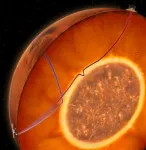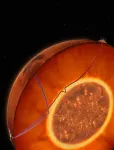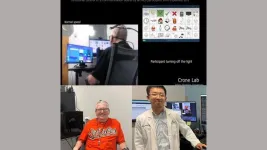(Press-News.org) The first data from the InSight mission made it possible to determine the internal structure of Mars in a series of papers from the scientific team published in the summer of 2021. However, since then, the analysis of new data generated by a powerful meteorite impact that occurred on September 18 2021, questioned the first estimates of the internal structure of the Red Planet. By studying the propagation times of waves generated by this impact, an international team led by Henri Samuel, CNRS researcher at the Institut de Pysique duGlobe de Paris, and involving scientists from CNRS, ISAE-SUPAERO and Université Paris Cité supported by CNES and ANR, as well as co-authors from the Royal Observatory of Belgium, the Universities of Maryland and Bristol, the Zürich Polytechnic School, the Russian Academy of Sciences, and NASA's Jet Propulsion Laboratory, demonstrated the presence of a molten silicate layer at the base of the Martian mantle overlying the metallic core.
This new structure model, published on October 26, 2023 in the journal Nature, is not only more consistent realistic with all available the geophysical data, but also explains better the evolution of Mars since its formation.
In particular, the evidence of this stratification of the Martian mantle elucidates the abnormally slow propagation, hitherto unexplained, of diffracted waves from the September 2021 meteorite impact by their trajectory in the lower and fully molten part of the basal layer, where seismic velocities are low. Furthermore, for several older seismic events, the arrival times of waves measured at the surface of Mars are compatible with reflections of shear waves at the top of the molten layer (located several tens of kilometers above the metallic core) and not at the core-mantle interface, as previously assumed. Finally, the presence of this basal layer helps explain the observed trajectory of Phobos, Mars's closest moon. Indeed, the upper and partially molten part of the basal layer efficiently dissipates the deformations generated by Phobos's gravitational attraction. In contrast, the solid mantle above this layer is more rigid and seismically poorly attenuating, as suggested by the detection at the surface of Mars of waves associated with seismic events of relatively low magnitude.
A smaller, denser core than envisaged
The presence of this molten layer at the base of the mantle implies a metallic core 150 to 170 km smaller (i.e., a radius of 1650±20 km) and 5 to 8% denser (i.e., 6.5 g/cm3) than previous seismic estimates. This denser core would therefore be composed of an alloy with fewer light elements than previously required, and more compatible with cosmochemical data from the analysis of Martian meteorites and high-pressure experiments. The authors of the study therefore propose that Mars probably experienced an early magma ocean stage whose crystallization produced a stable layer at the base of the mantle, highly enriched in iron and radioactive elements. The heat released by the latter generated a basal layer of molten silicates located above the core, overlain by a thinner partially molten layer.
The study further states that such stratification of the mantle insulates the metal core, thereby preventing it from cooling and generating a thermal dynamo. “The thermal blanketing of Mars's metallic core by the liquid layer at the base of the mantle implies that external sources are necessary to generate the magnetic field recorded in the Martian crust during the first 500-800 million years of its evolution. These sources could be energetic impacts, or core motion generated by gravitational interactions with ancient satellites which have since then disappeared”, explains Henri Samuel.
This stratified structure of the interior of the mantle of Mars, which contrasts with that of the Earth indicates different internal evolution of these two planets. Mélanie Drilleau, research engineer at ISAE-SUPAERO and co-author of the study, explains that “the discovery of this stratification in the Martian mantle opens new research horizons, since the seismic data recorded by the SEIS instrument of the InSight mission will now be reconsidered in the light of this new paradigm.”
About InSight and SEIS:
NASA's InSight mission officially ended in December 2022 after more than four years of collecting unique science data on Mars.
JPL managed the InSight mission on behalf of NASA's Science Mission Directorate. InSight is part of NASA's Discovery program, managed by the Marshall Space Flight Center (MSFC), NASA's Huntsville, Alabama facility. Lockheed Martin Space in Denver built the InSight probe, including its cruise stage and lander, and supported operation of the spacecraft for the mission. CNES was the prime contractor for SEIS and the Paris Institute of Globe Physics (Université Paris Cité/IPGP/CNRS) assumed scientific responsibility. CNES finances the French contributions, coordinates the international consortium (*) and was responsible for the integration, testing and supply of the complete instrument to NASA. IPGP designed the VBB (Very Broad Band) sensors, tested them before their delivery to CNES and contributes to the operation of VBBs on Mars.
The SEIS and APSS operations were carried out by CNES within FOCSE-SISMOC, with the support of the Centro de Astrobiologia (Spain). SEIS data are formatted and distributed by the Mars SEIS Data Service of IPG Paris, as part of the National Observation Service InSight to which LPG also contributes and, for Seismo activities at the School, GéoAzur. Daily identification of earthquakes was carried out by InSight's Mars Quake Service, a collaborative operational service led by ETH Zurich to which seismologists from IPG Paris, the University of Bristol (UK) and Imperial College London ( UK).
Several other CNRS laboratories including LMD (CNRS/ENS Paris/Ecole polytechnique/Sorbonne University), LPG (CNRS/Nantes University/Le Mans University/University of Angers), IRAP (CNRS/University of Toulouse/CNES ), the LGL-TPE (CNRS/Ecole Normale Supérieure de Lyon/Claude Bernard University Lyon 1), the IMPMC (Sorbonne University/National Museum of Natural History/CNRS) and LAGRANGE (CNRS/Université Côte d'Azur/Observatoire of the Côte d'Azur) are participating with the IPGP and ISAE-SUPAERO in the analysis of data from the InSight mission. These analyzes are supported by CNES and the National Research Agency as part of the ANR MArs Geophysical InSight (MAGIS) project.
(*) in collaboration with SODERN for the production of the VBB, the JPL, the Swiss Federal Institute of Technology in Zurich (ETH, Zurich Switzerland), the Max Planck Institute for Solar System Research (MPS, Göttingen, Germany), the Imperial College London and the University of Oxford provided the SEIS subsystems and are involved in the scientific exploitation of SEIS.
END
InSight seismic data reveals a molten layer at the base of the Martian mantle
2023-10-25
ELSE PRESS RELEASES FROM THIS DATE:
Scientists discover molten layer covering Martian core
2023-10-25
NASA’s InSight mission to Mars helped scientists map out Mars’ internal structure, including the size and composition of its core, and provided general hints about its tumultuous formation.
But findings from a new paper published in the journal Nature could lead to reanalysis of that data. An international team of researchers discovered the presence of a molten silicate layer overlying Mars’ metallic core—providing new insights into how Mars formed, evolved and became the barren planet it is today.
Published on October 25, 2023, the team’s paper details the use of seismic data to locate and identify a thin layer of molten ...
Sediment core analysis supports new epoch characterized by human impact on planet
2023-10-25
Scientists have long debated the Anthropocene Epoch, a proposed unit of geologic time corresponding to the most recent period in history. It’s characterized by substantial human impact on the planet.
Are we living in the Anthropocene? And if we are, then when did it start?
In a research article published this month in The Proceedings of the National Academy of Sciences, The University of Toledo’s Dr. Trisha Spanbauer and Stanford University’s Dr. M. Allison Stegner lend credence to the argument for its existence. The pair analyzed open-source data to track vegetation ...
Romance or nomance? Adolescents prefer to see less sex, more friendships, platonic relationships on screen
2023-10-25
Key takeaways
47.5% of respondents ages 13–24 feel most TV shows and movie plots don’t need sexual content; 51.5% want to see more focus on friendships and platonic relationships.
56% of those aged 10–24 prefer original content over franchises and remakes.
Twice as many adolescents prefer binge releases over weekly drops.
Adolescents want to see lives like their own depicted on screen.
This year’s Teens & Screens report from UCLA’s Center for Scholars & Storytellers, or CSS, found that teens — plus the 18- to 24-year-old demographic that advertisers typically ...
UK air pollution regulations will reduce deaths, but do little to protect ecosystems
2023-10-25
Existing air pollution regulations will reduce thousands of premature adult deaths in the UK, but even the most effective technically feasible actions, which will save thousands more lives, will do little to protect the country’s sensitive ecosystems, find UCL researchers.
The new research, published in GeoHealth, found that existing air pollution regulations could avoid 6,751 early deaths amongst adults in the UK by 2030 compared to if no regulations existed. That estimate nearly doubles to 13,269 avoided adult premature deaths if all possible technically feasible measures are employed to reduce air pollution immediately.
However, existing regulations don’t ...
Brain-computer interface restores control of home devices for Johns Hopkins patient with ALS
2023-10-25
It’s the day after the Baltimore Orioles clinched the American League East Championship with their 100th win of the season, and lifelong fan Tim Evans is showing his pride on his sleeve.
“It’s so great,” Evans, 62, says with a huge smile, wearing his orange O’s jersey.
The last time the Orioles won the AL East was in 2014, the same year Evans was diagnosed with amyotrophic lateral sclerosis (ALS), a progressive nervous system disease that causes muscle weakness and loss of motor and speech functions. Evans currently has severe speech and swallowing problems. He can talk slowly, but it’s hard for most people to understand him.
However, ...
Screen printed electrodes for measuring endothelial barrier integrity
2023-10-25
(LOS ANGELES) – October 25, 2023 - The Terasaki Institute for Biomedical Innovation (TIBI) has developed a novel organ-on-a-chip device for measuring electrical resistance across endothelial barriers. This chip had carbon-based, screen-printed electrodes incorporated into a multi-layered, microfluidic chip fabricated by a simple and cost-effective method.
Endothelial cells line blood and lymph vessels of the body and form a barrier layer which controls the flow of fluid and substances to and from the vessels and surrounding tissues. Study of the crucial roles ...
UTSA researchers receive $3.6 million National Science Foundation grant to break down language barriers in engineering education
2023-10-25
(SAN ANTONIO, OCTOBER 25, 2023)—The National Science Foundation (NSF) has awarded a five-year, $3.6 million grant to two professors at The University of Texas at San Antonio (UTSA) to develop a better way to communicate engineering acumen to diverse engineering classes.
Joel Alejandro Mejia and M. Sidury Christiansen are collaborating on an ethnographic project, “Rhetorical Engineering Education to Support Proactive Equity Teaching and Outcomes (RESPETO).” The project will include a handbook of recommended pedagogical approaches to address exclusionary language and linguistic practices in engineering classes.
The project was motivated by several factors. Among them, ...
Marketing research is too narrow: Hw the field must change to keep producing relevant, timely knowledge
2023-10-25
Researchers from TU Dortmund University and RWTH Aachen University published a new Journal of Marketing article that examines how specific types of marketing knowledge contributions have developed over the past few decades and suggests ways to move the field toward “big picture” theories that will have greater impact.
The study, forthcoming in the Journal of Marketing, is titled “Conceptual Contributions in Marketing Scholarship: Patterns, Mechanisms, and Rebalancing Options” and is authored by Bastian Kindermann, ...
Sunflower extract fights fungi to keep blueberries fresh
2023-10-25
Opening a clamshell of berries and seeing them coated in fuzzy mold is a downer. And it’s no small problem. Gray mold and other fungi, which cause fruit to rot, lead to significant economic losses and food waste. Now, researchers report in ACS’ Journal of Agricultural and Food Chemistry that compounds from sunflower crop waste prevented rotting in blueberries. They suggest the food industry could use these natural compounds to protect against postharvest diseases.
Sunflowers are cultivated around the world for their seeds and oil, but the flower stems — known as receptacles — are generally considered to be a waste product. Noting that this crop is particularly ...
Global platform study presents results to guide care of severely ill patients with COVID-19 using routinely available drugs
2023-10-25
The Global Coalition for Adaptive Research (GCAR) in collaboration with the University of Pittsburgh and UPMC, on behalf of the REMAP-CAP Investigator Network, announce clinical trial results examining the use of vitamin C and simvastatin to treat severely ill patients with COVID-19.
Published today in JAMA and NEJM, and presented at the European Society of Intensive Care Medicine in Milan, the studies are part of the ongoing Randomized Embedded Multifactorial Adaptive Platform for Community Acquired Pneumonia (REMAP-CAP) trial.
Simvastatin, a widely available and inexpensive drug that is included on the WHO list of essential medicines, ...







